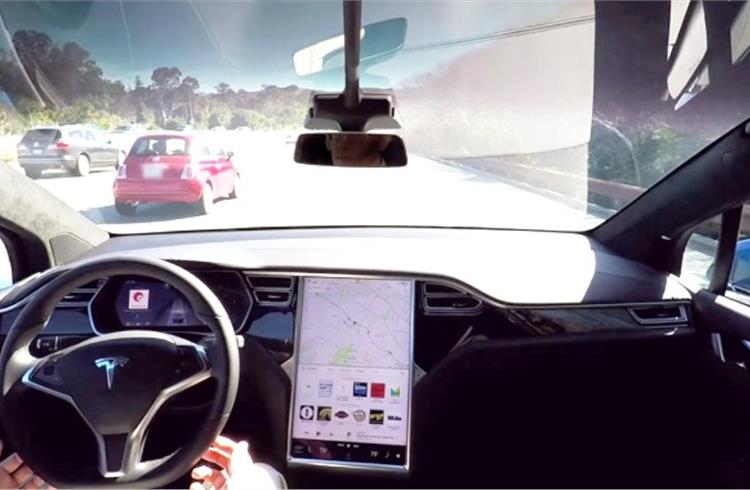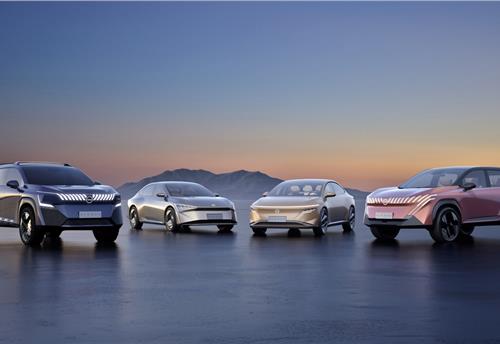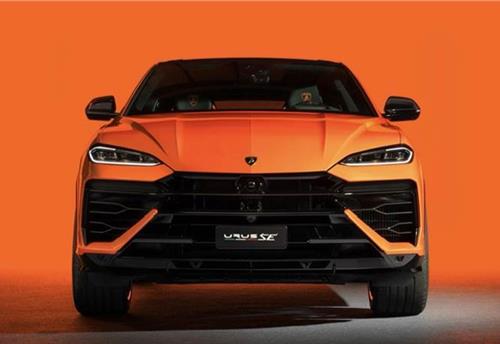All Tesla cars in production to now have full self-driving hardware
All cars being produced now have the hardware needed for a fully autonomous mode, but the software required to utilise it won’t arrive until 2017.
All new Tesla cars are now being equipped with the necessary hardware to enable fully autonomous driving modes.
Tesla says it's now fitting its cars with eight surround cameras to provide 360deg visibility around the car of up to 250 meters away. These are accompanied by 12 updated ultrasonic sensors, allowing for detection of both hard and 'soft' objects at nearly twice the distance of the previous system. Additionally, a forward-facing radar that can see through heavy rain, fog, dust and even underneath the car ahead has been added to complete the spectrum of vision.
However, while the hardware is fitted to Model X and Model S cars rolling off the production line now, it can't be fully used until the required software is finished and added to the models' operating systems via over-the-air updates.
Tesla CEO Elon Musk said in a tweet that this software should arrive in late 2017, meaning we could be a year away from full Autopilot technology, which Tesla claims will enable passengers to travel from New York to Los Angeles without touching the steering wheel.
Tesla is yet to confirm details, but the limited information it has revealed include that the Autopilot technology, while significantly more effective than the current system, will still be limited to operating on highways and multi-lane roads. The new software will likely mark the most significant step towards a fully autonomous vehicle, though.
Recent software upgrades for current cars
Last month Tesla announced a new over-the-air update for the Model S and Model X's Autopilot software would reduce crashes involving the vehicles by as much as half.
The new software is part of the v8.0 update and comes with a range of improvements to the Autopilot system, allowing the cars' radar systems to register far more objects than before. "The new software enables the car to initiate braking no matter what the object is – especially if it's large, metallic and dense... It could be a truck crossing the road, a road sign, it could even be a spaceship or a pile of junk metal," said Musk.
No additional hardware is required for the v8.0 improvements, so all radar-equipped Model S and Model X cars built in the past two years will benefit from the wirelessly downloadable update. Speaking to Autocar UK in the late summer, Musk confirmed that the update would be applied to models worldwide, including those in the UK.
Once downloaded, the cars will not only recognise more objects on the road but will also be able to use something Musk calls 'radar echo'. This technology bounces radar off the road and underneath the car in front and then back off objects ahead of that. Musk said: "Now, if the car in front of you suddenly swerves, we've already seen the obstacle in front."
When questioned by Autocar UK about the reliability of radar echo - if a radar pulse tried to bounce under a very low car directly in front, for example - Musk said: “It would have to be very very low. Even if a car had 6.0in clearance, it should be able to work.” He added that the radar would also try and “bounce around the car and through the glasshouse of the car”.
The system also improves on Autopilot's geocoding functions, flagging up false positives into GPS map data so that in the future, Teslas passing that point will be aware of whatever object it is that caused the previous car's auto-braking alarm. The system also gets better lane detection by downloading geocoded lane widths. It's all part of what Musk calls 'fleet-learning'.
Interestingly, Musk also revealed: "Autopilot accidents are far more common with expert users; they get very comfortable with the system." To help improve concentration among more laissez-faire Autopilot users, the new software update will force users to park up and restart the car if they choose to ignore three alarms telling them to put their hands back on the steering wheel.
Musk revealed he believes that the Model S and Model X are already the safest cars on the road by quite some margin, but claims that this update should improve safety further by as much as 50%.
"It's about improving the probability of safety; we have about 160,000 Tesla cars covering billions of miles, so even if it's one in a billion, there won't be zero injuries or zero fatalities," said Musk. He also commented on the recent death of a driver using Autopilot, saying he believes "it is probable" this update would have saved that man's life.
This announcement was the latest in a line of continual improvements from Tesla. Musk recently confirmed the arrival of a 100kWh battery pack for the Model S and Model X, which will make the Model S P100D the quickest car in the world. In July, Musk also revealed his 'Masterplan, part two', which unveiled plans for a compact SUV and a pick-up truck.
Source: Autocar UK
RELATED ARTICLES
Kia displays EV5 and Sonet SUVs for Chinese market
Kia has unveiled a number of key models and new technologies for Chinese customers at the 2024 Beijing International Aut...
Nissan targets growth in China, unveils four NEV concepts at Beijing Motor Show
The two EVs and two plug-in hybrids are a joint effort with Nissan’s local partner Dong Feng and aimed to better address...
Lamborghini unveils Urus SE ahead of Auto China 2024
Electric-only range of 60km helps reduce emissions by 80%.





 20 Oct 2016
20 Oct 2016
 4272 Views
4272 Views





 Autocar Pro News Desk
Autocar Pro News Desk




